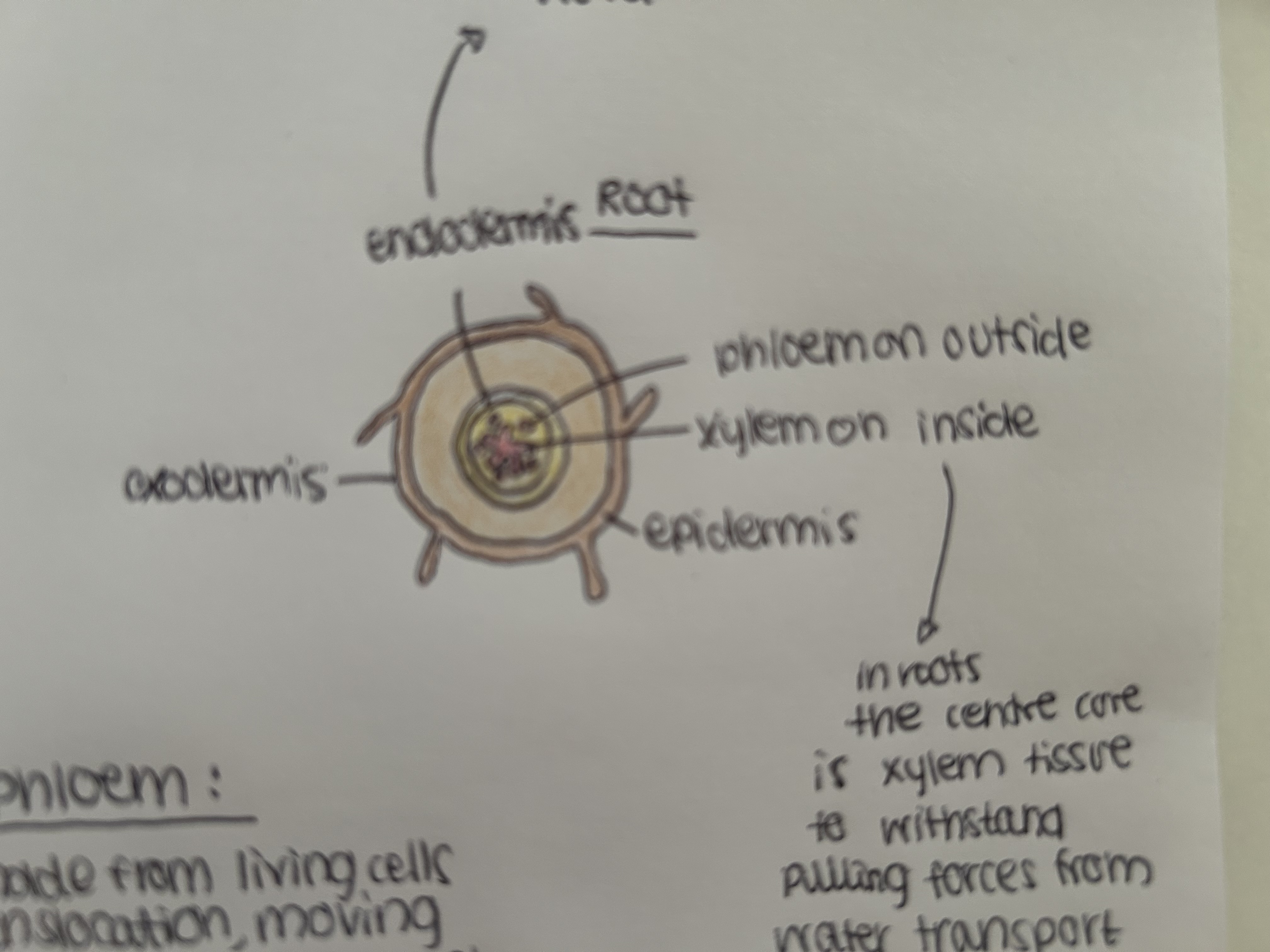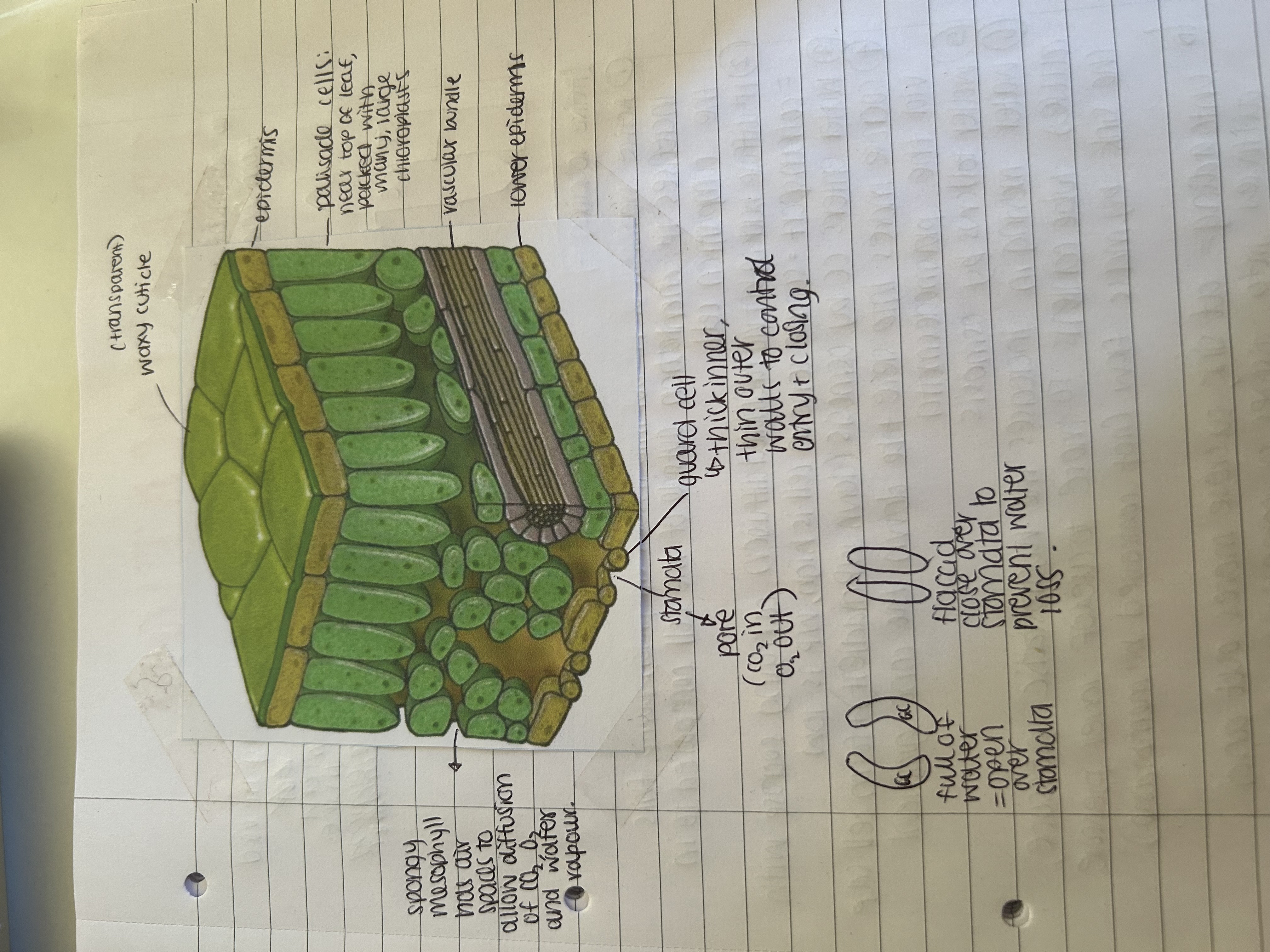transport in plants
1/24
There's no tags or description
Looks like no tags are added yet.
Name | Mastery | Learn | Test | Matching | Spaced |
|---|
No study sessions yet.
25 Terms
What is a dicotyledonous plant
Produces two seed leaves
Has broad surfaces leaves
Has a network of veins running throughout
Visualise the composition of the stem
Xylem inside phloem outside

Why do the stems have xylems on the inside ?
To help support the plant and for flexibility, due to the lignin in its cell walls
Why is there parenchyma in the stem and where
In the centre for storage and strengthening fibres
Visualise the root

What does the endodermis do
Supply the xylem with water
Why is the xylem on the inside of the root
To help the plant withstand pulling forces like of water and growth aka mechanical forces
Name all the facts you know about the xylem
they have bordered pits
A long continuous column with no end plates
Cell has dead lignin in its walls which thickens it and has spiral patterns for flexibility
Transports water up the plant
Name all the facts you know about phloems
transports assimilates (organic compounds) from the source leaf to sink root up and down the plant
Consist of sieve tube cells and companion cells that are linked in cytoplasm by their plasmodesmata allowing comms and flow of substances eg minerals
Companion cells help in active loading of sucrose
Sieve tube elements are what actually make the tube up
Where does water move to in a plant
A place of lower water potential, more negative
Describe the apoplast pathway
Water moves thru the cellulose fluid filled cell walls
the walls are thick and open so it’s easy for water to move thru as no cell membranes
little control
stops at the endodermis due to waterproof casparian strip made from Suberin- forced water into the cellulose fluid filled by passing thru membrane to go into the simplest pathway - membrane selectively permeable so can control xylem water uptake
Desc the symplast pathway
Water travels through cytoplasm connected by plasmodesmata in gaps in cell walls
Desc movement of water through soil into root
Cells in epidermis of root actively transport minerals in so lowers WP so water moves into root hair cell cytoplasm by osmosis down the concentration gradient
What three ways does water move up stem ?
Capillary action
Transpirational pull
Root pressure
Desc capillary action
Cohesion = attraction to other water molecules
Adhesion = attraction to xylem walls
Desc root pressure
Water and minerals move into xylem from the root which pushes water in xylem up a few cm
Desc transpirational pull
Cohesive forces of water form a long column, if water gets lost at the top by transpiration more must be drawn up the stem, that pulling creates tension and lignin is what’s helping the plant to stay intact and not break because it strengthens and toughened the wall
If the column gets broken water can flow into the adjacent xylem vessels by the bordered pits
How do the following affect transpiration rate :
light
Temperature
Wind
Humidity
Water availability
Light = increase as stomata open
Temp= increase as more KE and WP gradient higher
Humidity = decrease as WP gradient lower
Air = increase as less humidity blowing away water vapour and maintains gradient by blowing water Vapor away
Water = decrease as stomata will close up
Xerophyte adaptations
small leaves like pines or needles to reduce the surface area for transpiration
Sunken stomata and hairs to trap moist air, effectively increasing the humidity so the diffusion gradient and reducing transpiration
Thick waxy cuticle
Fewer stomata
Hydorphyte adaptations
Large flat leaves that are buoyant so they can be on the surface close to the sun and have a large SA
Thinly lignified walls
Thin waxy cuticle
Stomata on upper surface of leaf to exchange with air not water
Xylem is reduced as less need to transport water
Cells adapted to not absorb too much water via cell wall
Plant adaptations

What actyally is translocation
Movement of assimilates from source eg where it’s made (leaf) or where ist stored eg tuber, seeds etc to where it is used eg meristem, growing flowers/ developing seeds etc
Describe active loading
H+ ions pumped out of companion cell by proton pumps via active transport, increasing conc outside of the cell and decreasing inside
H+ move back in but via cotransporter proteins with sucrose attached
Sucrose enters cell and reduces WP
Water moves into cell via osmosis forming cell sap with sucrose
Sucrose diffuses down a conc gradient into the sieve tube
Water follows and its addition causes hydrostatic pressure so the contents move to the area of lower pressure, sink. They move by mass flow
What is unloading ?
At the sink the sucrose moves out and diffuses into that tissues to be used up
What is the mass flow hypothesis
Due to presence of a hydrostatic pressure gradient- Starts from the active loading of sucrose into sieve tube at source , causing water to move in but at the same time sucrose is being unloaded at sink, water ofc follows and this lowers the hydrostatic pressure at the sink